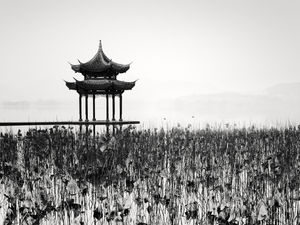top of page


Landscapes and Minimalism: The Influence of Japanese Sansui in Photography
Sansui refers to the artistic representation of landscapes in Japan. A genre that has played a central role in traditional painting,...


Landscapes and Minimalism: The Influence of Chinese Shanshui in Photography
Shanshui (山水), which literally means "mountain-water" in Chinese, is an artistic and philosophical concept of landscape representation...


Japan: Jingu, Taisha, Jinja, the Hierarchy of Shinto Shrines
Shinto shrines in Japan are categorized into several groups, each with its specific significance and importance. Ranging from small local...


China: Yuyuan, the Garden of Harmony and Health in Shanghai
Yuyuan Garden, located in the old town of Shanghai, is an outstanding example of the classical Chinese gardens of the southern Yangzi...


China: The Residence of Hu Xueyan in Hangzhou, an Empire and its Decline
The Residence of Hu Xueyan in Hangzhou is a historic residential complex located in Hangzhou, Zhejiang Province. Hu Xueyan was a very...


Japan: Inuyama Castle, the Fortress of the White Emperor
Inuyama Castle, located in Aichi Prefecture, is one of the oldest existing Japanese castles. It is renowned for its original keep dating back to the Azuchi-Momoyama period. Its history is rich with events, important figures, and transitional periods. Situated atop a wooded hill, it makes for an interesting photographic subject. Fine Art Print © O. Robert (Purchase here) Inuyama Castle is a cornerstone of Japanese history, reflecting architectural evolutions, military conflict


Japan: Photographing the 88 Temples of the Henro Pilgrimage (Part 2)
The pilgrimage around the island of Shikoku, also known as Henro in Japanese, involves connecting 88 temples of Shingon Buddhism, spread across 4 prefectures. Several thousand pilgrims venture each year on these paths, which are about 1200 kilometers long. Traditionally, these pilgrims, called Ohenro, travel on foot this ambitious journey in a personal quest. Explanations and advice for photographing the temples and the grandiose landscapes of this pilgrimage. Fine Art Print


Japan: Henro, the Pilgrimage of the 88 Temples of Shikoku (Part 1)
The pilgrimage around the island of Shikoku, also known as Henro in Japanese, involves connecting 88 temples of Shingon Buddhism, spread across 4 prefectures. Several thousand pilgrims venture onto these paths spanning about 1200 kilometers every year. Traditionally, the pilgrims, called Ohenro, travel on foot on this ambitious journey in a personal quest. History, challenge, and organization of the most famous pilgrimage in Japan. Fine Art Print © O. Robert (Purchase here) E


Japan: Photographing the Seaweed Cultures of the Ariake Sea
The Nori seaweed farms, with their entanglement of geometric nets, offer a unique landscape for photographers, especially in the field of minimalism. These structures lend themselves to interesting artistic compositions. They highlight the duality and ephemeral beauty of nature, as well as our intrinsic relationship with it. Fine Art Print © O. Robert (Purchase here) The Ariake Sea, located on the island of Kyushu, is known for being the country's largest inland bay. Characte


Japan: Matsue Castle, a National Treasure Standing the Test of Time
Matsue Castle, also known as "Pine Castle", is located in Shimane Prefecture, in the beautiful San-in region. It's one of the few castles in Japan whose main tower has survived wars and natural disasters since the Edo period, making it a precious testament to Japanese military architecture. An interesting relic in photography, especially at night. Fine Art Print © O. Robert (Purchase here) History of Matsue Castle Matsue Castle (松江城, Matsue-jō) was built between 1607 and 161


Japan: 5 Essential Gardens for Landscape Photography
The art of Japanese gardens is imbued with mysteries. These miniature representations of imaginary or existing landscapes offer landscape architects an infinite margin for personal expression. Although these gardens can be classified into styles corresponding to specific periods, they remain peaceful places of contemplation for the visitor. Here is a selection of 5 historical gardens that have particularly fascinated me in all seasons. © O. Robert To offer scenes that challen


Japan: The Nori Seaweed Farms of the Ariake Sea
Nori seaweed, emblematic of Japanese cuisine, embodies a rich tradition and a unique symbiosis between humans and the sea. It is in the heart of Ariake Bay, a distinctive region of Kyushu Island, that this ancestral tradition reaches its pinnacle. A craftsmanship that represents both the simplicity and the cultural richness of Japan. Fine Art Print © O. Robert (Purchase here) In the calm waters of Ariake, farmers, or rather "aquaculturists," engage in the meticulous cultivati


Japan: Tanajibu, the Fishing Huts on the Ariake Sea
Nestled in the heart of Kyushu's maritime landscapes, the Tanajibu, these traditional fishing huts, emerge as sentinels over the Ariake Sea. These structures, perched on stilts and battered by the tides, represent a fascinating chapter of harmony between man and sea, a living tableau of age-old traditions that defy time. Fine Art Print © O. Robert (Purchase here) In this article, I invite you to explore the world of the Tanajibu, delving into their construction, significance,


Shui-mo: From Brush to Film, a Dialogue Between Painting and Photography
A personal and introspective look at how these art forms, separated by time and culture, converge in their pursuit of minimalism. Drawing...


Japan: The Floating Torii of Itsukushima Jinja
The Grand Torii of Itsukushima Shrine is one of Japan’s most iconic symbols and one of the most famous torii gates in the country. Standing in the sea, about 200 meters offshore, it is part of the most photographed sites of Japan. Itsukushima Torii | Fine Art Print © O. Robert (Available for purchase here) This “floating” torii, has garnered international fame due to its striking appearance, spiritual significance, and integration with the natural surroundings. It has existed


Japan: The Yushi-en Garden in Matsue
There are rare moments in a photographer's life that leave an indelible impression on their mind. An encounter or a discovery often provides the opportunity to capture some stunning shots, or at the very least, to preserve an unalterable memory. This was my case when I discovered this garden for the first time. Yushi-en remains one of the most beautiful gardens I have ever visited in Japan. © O. Robert It's obviously a matter of personal taste. But having visited hundreds of


China: The Village of Hongcun, Guardian of Huizhou Culture
The village of Hongcun is located in Anhui province and represents a remarkable example of the region's traditional Chinese architecture....


Japan: The Garden of the Adachi Museum of Art in Yasugi
This private museum, created by Mr. Adachi Zenko in 1970, houses an exceptional collection of paintings by Yokoyama Taikan and various other Japanese artworks. A passionate lover of gardens and a major art collector, Adachi Zenko wanted to create this museum and garden as a tribute to his hometown, while also contributing to the cultural development of Shimane Prefecture. © O. Robert His aim was to connect his collection of Yokoyama Taikan paintings with a lush garden. Intere


Shui-mo: The Art of Chinese Ink Painting as a Source of Inspiration
The Shui-mo is an ancient and sophisticated art of Chinese ink painting that transcends the boundaries of geography and time. It was once...


Japan: Itsukushima Jinja, the Shrine of the Three Deities
Itsukushima Shrine is located on the sacred island of Itsukushima (commonly referred to as Miyajima) in Hiroshima Prefecture. As part of the "Three Views of Japan", it is one of the most famous Shinto shrines and an iconic site, internationally known for its “floating” torii gate. Its history is spanning centuries and blending religious significance with legends and war periods. © O. Robert Itsukushima Shrine is a symbol of Japan's cultural and spiritual identity, embodying c


China: 9 Spots for Minimalist Photography Around West Lake (Part 3)
The city of Hangzhou is a historical and cultural gem of China. West Lake, in turn, is a significant source of artistic and literary...


China: Getting to Hangzhou and Photographing the West Lake (Part 2)
The city of Hangzhou is a historical and cultural jewel of China. The West Lake, in turn, is a significant source of artistic and...


China: Hangzhou and the West Lake, 2000 Years of Cultural History (Part 1)
The city of Hangzhou is a historical and cultural jewel of China. West Lake, on the other hand, is an important source of artistic and...


Japan: Shingon Buddhism, the Path of Enlightenment According to Kukai
Shingon is a school of Japanese Buddhism, also referred to as tantric Buddhism or Vajrayana Buddhism. This school is based on esoteric teachings that use rituals, meditations, and mantras to achieve enlightenment. This spiritual tradition was introduced to Japan in the early 9th century by Kukai, later known as Kobo Daishi. Danjo Garan, Koyasan. Fine Art Print © O. Robert (Purchase here) From ancient roots to modern practice, let's see how Shingon has shaped Japanese spiritua
bottom of page



